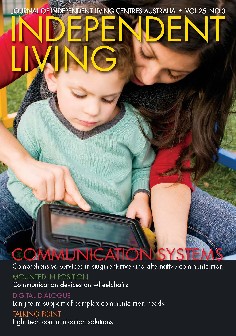
Publications
Independent LivingVolume 25 No 3
published in September 2009
Featured Articles
Mounting in position - Considerations to be taken
By Justin Ware, Occupational Therapist, Tasc Consultancy Service, The Spastic Centre, NSWAs technology improves, an increasing number of high-tech communication devices are coming on to the market. A critical component affecting the successful use of any communication device is its availability to the user throughout the day, in different environments. For a wheelchair user, the best way to ensure secure, consistent and functional positioning of a communication device is to have it mounted to the personís wheelchair.
Positioning a communication device on a personís wheelchair tray is not recommended as device could be dropped on to the floor. It also means that the device can move around on the tray, which can make access difficult for some device users. This article will discuss some of the considerations that need to be made when looking at mounting a communication device.
Communication systems
Comprehensive services in augmentative & alternative communications - By Janelle Sampson, Senior Speech Pathologist, Project Manager, Statewide Complex Communication Needs ProjectIn the field of augmentative and alternative communication (AAC), the importance of multimodal communication systems with consideration of both electronic and non-electronic options is not a new idea. However, the current trend of review and restructure of funding programs for assistive technology within most states is a timely reminder that we ensure the baby is not thrown out with the bathwater.
While we advocate and propose programs that allow people with complex communication needs (CCN) access to the incredible technology now available in speech generating devices, we must also remember the importance of integrating these systems with non-electronic (or low-tech) forms of communication. Without a holistic approach to assessment, prescription and ongoing review of all communication modalities and how they are used, those highly sought after funding dollars for expensive devices will not be utilized to their full potential.
Speech generating devices
Providing users with a way to generate spoken messages - By Esther Bird, Speech Pathologist, COMTEC, Yooralla, VictoriaThe Term Speech Generating Devices (SGD) refers to a device which provides the user with a way of generating a spoken message Ė by selectively playing a message with human-recorded voice (digitised speech) or by using a computer-generated voice (synthesised speech). They have previously been known by the terms Electronic Communication Devices and Voice Output Communication Aids.
Speech Generating Devices fall into the category of Augmentative and Alternative Communication (AAC), that is, systems and strategies that expand on, or offer an alternative to using natural speech. Speech pathologists are trained and experienced in assisting people with speech and language difficulties and should be consulted when considering any form of AAC.
Developments in computer technology in the past few years have contributed to some rapid advances in SGD options available. Devices have become smaller, faster, increased in memory capacity and have expanded the range of functions they are able to perform.
Digital dialogue
Long term support using a speech generating device - By Diane Symons, Speech Pathologist, ILC Tasmania, Technology Access ServiceThe need for ongoing support of any assistive technology to prevent abandonment is well documented. However, this is not a case of potential assistive technology abandonment. Timís Pathfinder is essential to his everyday quality of life and he has no thoughts of abandoning his equipment.
Rather this is a case study of the support it requires to maintain his basic communication method and the support factors that limit his opportunities for further development and mastery.
